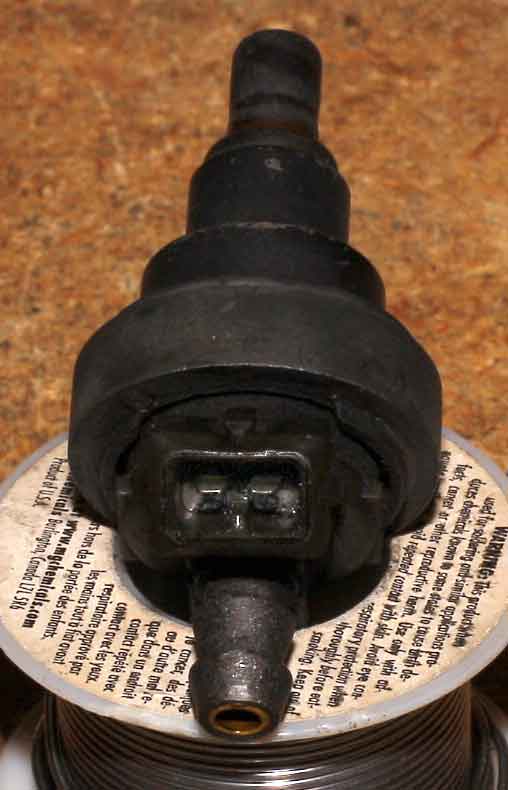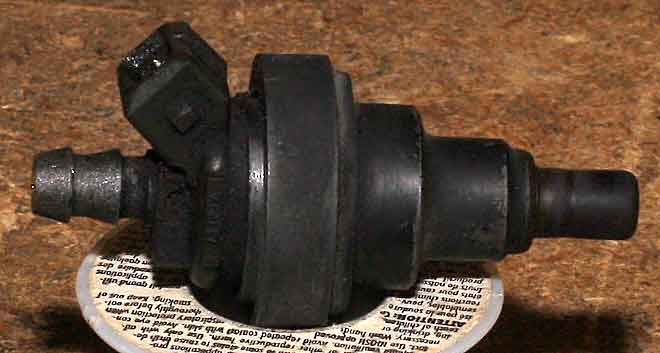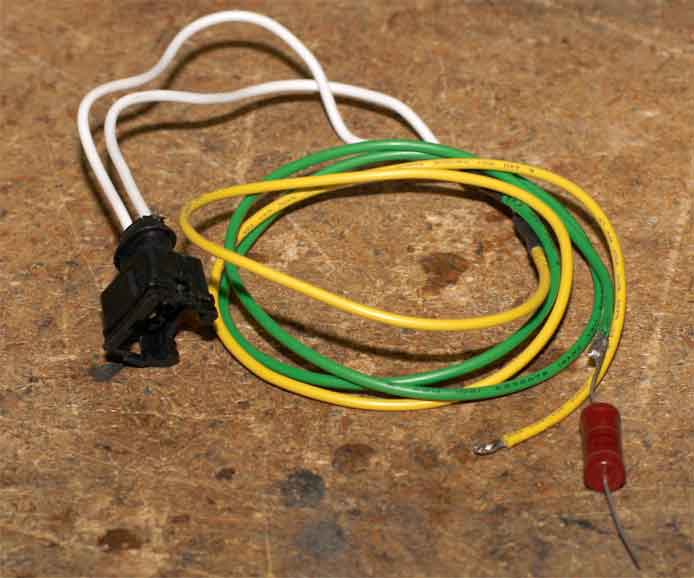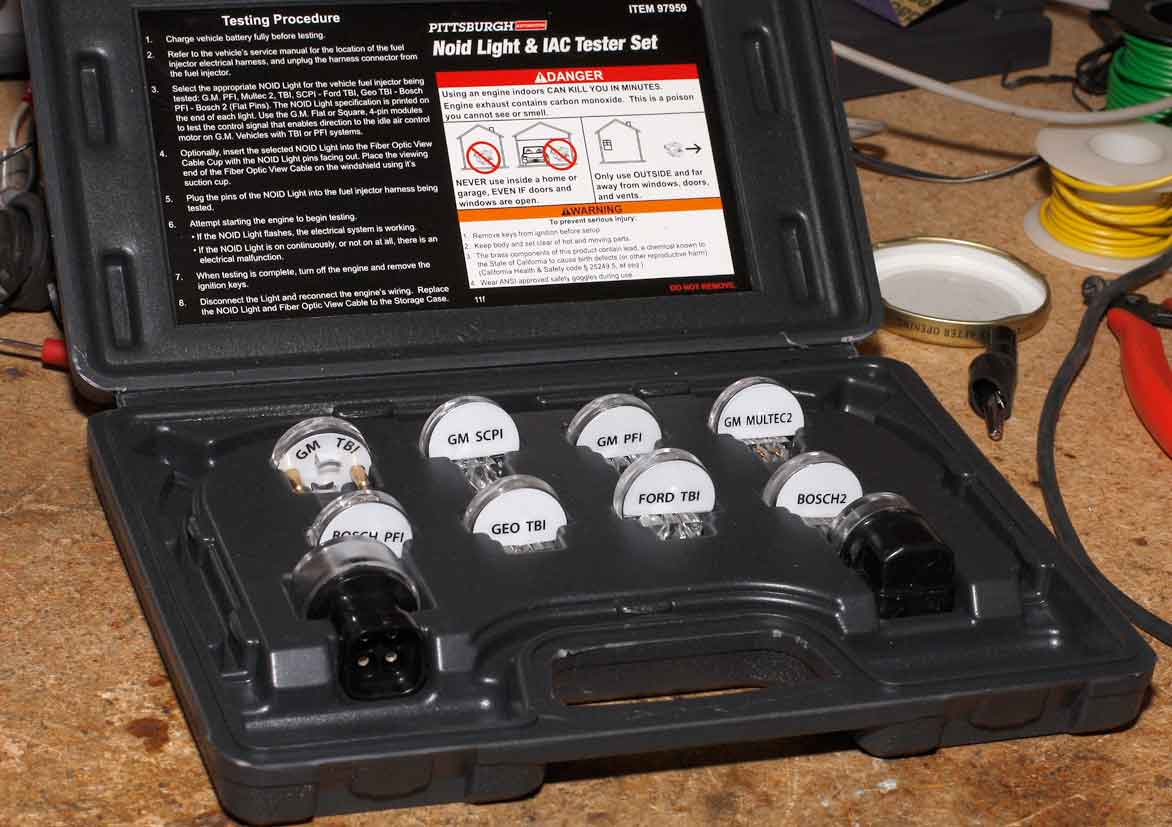 Long story short, I swapped the cylinder head on my car when the head gasket blew. The "new" cylinder head came from a junkyard engine with low miles. Due to the difficulty of removing the intake manifold from the head, I just left it on, so I ended up with the "new" head, a "new" intake manifold, and all the stuff that was attached to it—like the fuel injectors.
Long story short, I swapped the cylinder head on my car when the head gasket blew. The "new" cylinder head came from a junkyard engine with low miles. Due to the difficulty of removing the intake manifold from the head, I just left it on, so I ended up with the "new" head, a "new" intake manifold, and all the stuff that was attached to it—like the fuel injectors.
I started the car up and it ran very rough. I test showed that it was running on only three cylinders: 1, 5 and 6 were missing. I got spark on all cylinders, so the next likely problem was the injectors.
So this page is just what I've learned about fuel injectors, for what it's worth.
Very basically—an injector has a chamber that gasoline flows through: a fuel hose hooks on one end, and the opposite end goes into the combustion chamber. There's a spring-loaded pin inside that blocks the exit so fuel can't normally flow.
There's a little electromagnet inside. When you apply electricity, the electromagnet turns on and pulls the pin back, and the fuel flows. When the electricity shuts off, the electromagnet shuts off and the pin blocks the exit and fuel stops flowing.
There are a variety of ways to check injectors. When they're working properly they make a clicking sound—it's the sound of the pin pulling back. So if you're trying to start the engine and you don't hear any clicking, the fuel injectors aren't getting energized. Or if the engine is missing on a cylinder, you can try to use a mechanic's stethoscope (or a long screwdriver, or whatever else will telegraph the sound) and try to listen for clicking.
I didn't do this step. I went right to the next.
Checking for Signal
If the injector isn't working, it could be that the injector isn't getting an electrical signal from the computer, or it could be that it's getting the signal but the injector is stuck or broken. The difference is: is the problem inside the injector or is it outside the injector?
To test if the injector's getting an electrical signal, you can use a Noid Light. Basically it's a light with two (or four) prong connectors attached. You unplug the wiring socket to the injector (fairly easy to do), stick the light into the socket, and start the car. If the light flashes, you're getting a pulse from the computer. If the light doesn't flash or it stays steady, then you either have bad wiring somewhere or a problem with the ECU.
I got a kit from Harbor Freight (photo above). I'd rate it as "acceptable." The are ten different lights and the main difference is the size and configuration of the prongs (there may be voltage differences as well). The XK engine uses a Bosch/Lucas system, so the Bosch PFI light seemed to fit best.
A lot of kits, as did this one, come with a length of fiber-optic cable. The idea is you attach one end of the cable to the lamp and stick the other end on the windshield, that way if you're doing this by yourself, you can see the lamp from the driver's seat while you're cranking the engine. On the Harbor Freight kit, this worked about half the time. The big problem is that the plastic tube that attaches to the light doesn't do it very well, and I had a difficult time getting the light stuck in the socket and the fiberoptic tube at the same time. The other problem is that the suction cup that's supposed to stick the other end to the windshield doesn't stick to anything; they should coat omelette frying pans out of it.
I ended up chucking it and used wire-ties to lash the wiring and light in a position where I could see it. A better solution would have been just to use a remote starter so I didn't have to be inside the car at all. Some day I'll buy one.
My wiring checks out okay, so the problem is the fuel injectors.
Checking the Injectors
If you read the Jaguar shop manual (19.60.02), it says to check the resistance of the injector's internal winding (which is what creates the electromagnet). The book says the resistance is 2.4Ω at 68°F. I got 2.9Ω but it was a bit warmer, my ohmmeter isn't professionally calibrated and certified, and frankly I don't think a ½ ohm is going to make any difference, especially since they all measured exactly the same; I think all being the same is more important.
Another test is to check for shorts. Put one meter probe on one of the pins (doesn't matter which) and the other probe on the injector body (i.e. ground) and check continuity. There should be none. If there's an internal short, the injector is bad.
All mine passed these tests. So I figure they're probably clogged. I know there are ways to clean them without removing them but the ones I've seen are expensive. It's easier to clean them on the bench. Now as I mentioned at the top of the page, this is a "new" intake manifold, so I went to my original intake manifold and pulled out four injectors (they're attached in pairs). I figured I'd swap three of my originals for the three that aren't firing, and I'd clean the bad ones on the bench and put them on the shelf.

The shop manual says this about removing and reinstalling the injectors: "when refitting the injectors the sealing rings MUST be renewed." (19.60.01) Emphasis theirs.
The Jaguar parts book shows two O-rings, EAC2414 (big) and EAC2415 (small). Prices for the parts vary from outrageous to insane. The less expensive vendors I saw wanted about $2 for the small ones (each) and $4 for the large ones (each). One Jaguar seller wants $20 for a set of six of either the big ones or the small ones, so a complete set is $40!
To make it worse, when I was pricing these things, some companies were out of stock on all of them, my go-to vendor had one but not the other, and so on.
The Jag-Lovers forum's Parts Interchange List lists a much less expensive alternative, Standard Motor Parts SK3. There is also a Beck Arnley 158-0021, Borg-Warner's BWD Seal Kit 274021, and probably others. I ordered those from those the local auto parts store.
Turns out that at least on my car, you only need the one small one. It goes on the tip (right side on the photo above) and it fits into the hole in the manifold. I put the large ones on anyway, but they don't seem to serve any purpose, and I had to remove one because it made the injector too wide and was hitting something else. I'm guessing on earlier engines the big o-rings are needed, but not on the 1984s.
While I was waiting for my o-rings to arrive (becuase nobody in town had them on the shelf), I thought I'd check the injectors that I'd pulled from the old head. I bought a plug with wires (called a pigtail) that fits the Bosch/Lucas injectors, plugged it into an injector, and thought I'd see if I could energize it. I've got a variable DC power supply on my bench. I dialed in 12 volts, touched the probes to the two wires on the pigtail, and promptly blew the 1A fuse in my power supply.
Some experimenting, and I found that a 10Ω resistor would delivery enough current to fire the injector while limiting the current to keep the power supply fuse intact. Now I could make them click.
I played around a bit with the voltages. I found I could get them to work as low as 6 volts. Except for one, which didn't want to fire. So I started slowly cranking up the voltage until I got over 10, in which case it fired consistently. I dropped back down to 6 volts and it still worked. Gummed up just a little, perhaps?
I thought I'd try it out on the injectors in the engine, so I soldered on some wires to make it longer and added the resistor onto one wire. This would let me plug into the injector in the engine, drape the wires over the fender, and I could put the power supply on a rolling worktable next to the car.

If I wanted to do a lot of this, I'd hook this up to a battery pack or a 12V wall wart and add in a push-button switch. But for what I'm doing here, this is good enough.
Worked great for what I was doing. The car was missing on three cylinders—two, five and six. Injectors one, three, four, and five all "clicked." Two and six did not. I pulled two, five (anyway) and six and replaced them with injectors I'd tested on the bench. Two and six's misfire went away. Cylinder five still missed, but that turned out to be a compression problem.
I haven't played around with trying to clean the "bad" injectors yet. I'll leave that for later.

